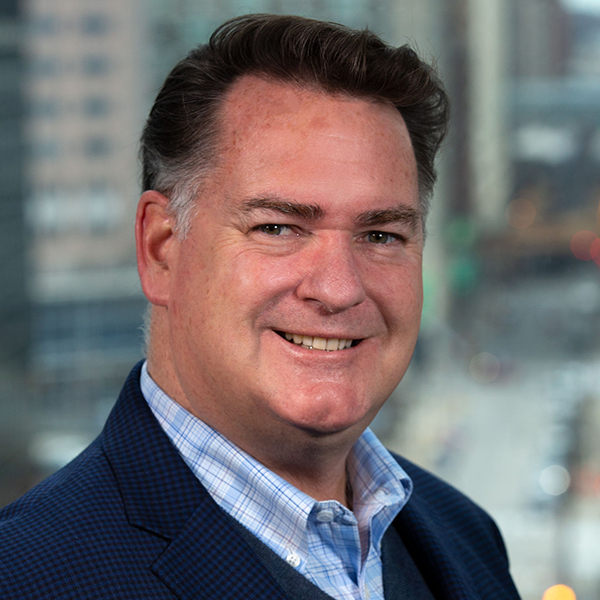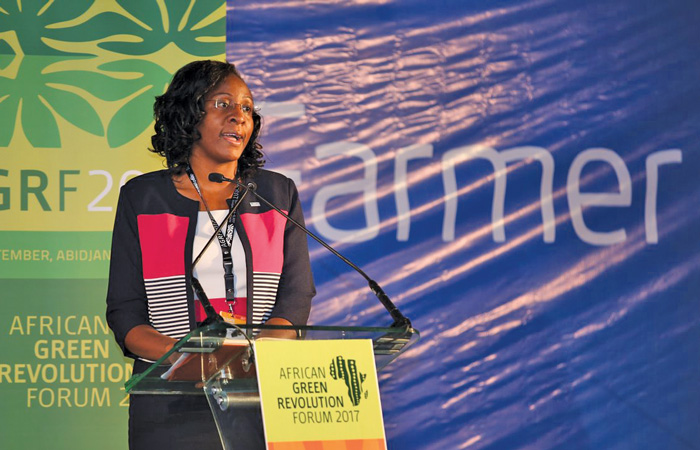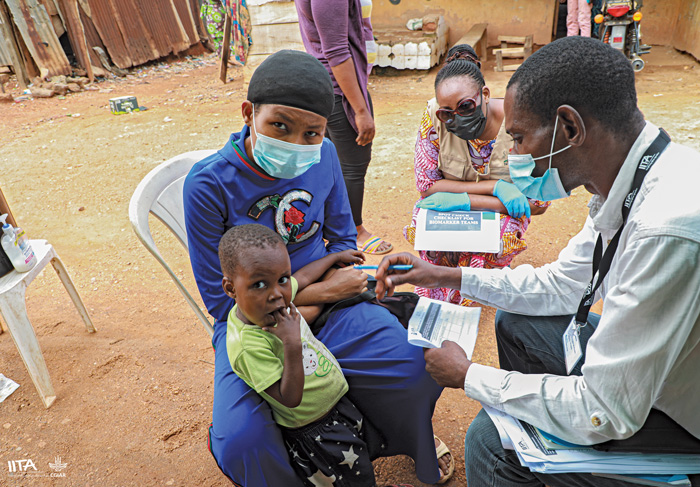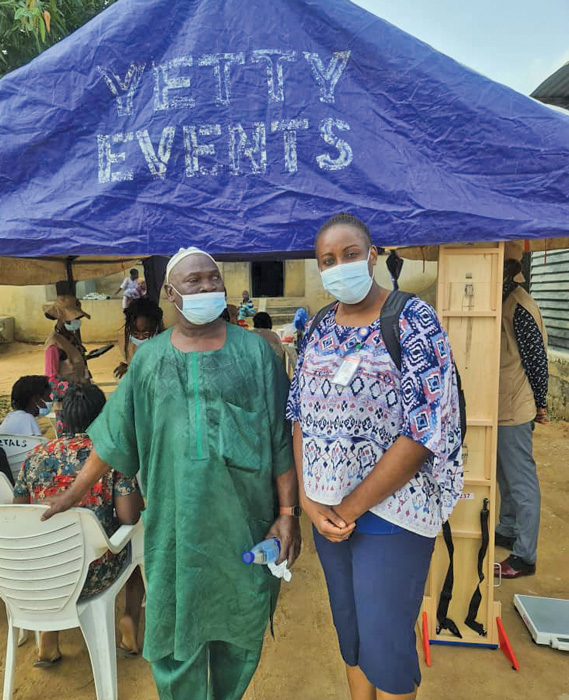
Resilience, Hope, and Mercy
Consultant and nutrition specialist Mercy Lung’aho advocates for a healthier food system throughout sub-Saharan Africa. She shares how a blend of life experience, cultural awareness, and political savvy inform her daily work as a scientist and challenges her peers to prioritize interdisciplinary dialogue to address food system challenges.
Article Content
The doctors thought she had only 72 hours to live. Born almost eight weeks premature, anemic, and weighing a mere 1.8 kilos, Mercy Lung’aho was on pace to become an infant mortality statistic.
Like many others, the regional hospital in Eldoret, Kenya, had few incubators to spare.
“But [the doctors] said, okay, let’s give her a shot,” Lung’aho says. “There was a nurse who would come in and just tell me, ‘Try, Gogo, try.’ Gogo in her mother tongue is ‘grandmother.’ ‘We need you to just make it to the third day. Fight.’
“I feel the same way when I’m in communities when I see challenges,” she says. “I say, no, we have to try; we can do this. Do we understand the problem? Do we have a potential solution? How do we make this work?”
Unknowingly, Lung’aho says, her early experience informed her study of food science at Cornell University, where her doctoral research focused on iron fortification of maize, and later efficacy studies of biofortified beans in Kigali, Rwanda. In her current role as a consultant and nutrition specialist at the International Center for Tropical Agriculture, as well as other international NGOs, Lung’aho acts as a scientific bridge between consumers, farmers, industry, and policy makers.
From her office in Ibadan, Nigeria, Lung’aho discussed how the intersection of science, sociology, policy, and business informs her work and broadens her perspective.
Your journey in food science seems very personal to you. What drew you to want to study this field?
I never thought when I grew up, I wanted to be a food scientist. All I knew was that I wanted to make an impact. And in my culture, that means you go to medical school, or you’re an architect or an engineer. I wasn’t interested in the other two. But I realized med school was not for me.
When my grandmother died, I met my aunt, who had gone to Cornell and was a food scientist. And in her prayer at the funeral, she asked that I follow in her legacy.
The first two years, I was not happy, until this semester when we started human nutrition. Then I found my spark, because then I realized I could still branch into nutrition and use what I was learning to help women and children in Africa.
How does food culture inform your work?
I come from a very generous and hospitable culture. Our culture around food is about sharing. It’s about kindness. So, for me, food became about people. It brought the community together. When I work with food, I don’t think of it just as what I’m working on. I’m thinking about the experience people will have when they’re interacting with the food. I also take it very personally. When I work on product development, I have a very strong co-creation component. I always go to the community. I get their feedback. And it’s taught me to be very observant.
Your doctoral research focused on iron deficiencies. Talk a bit about how that shapes the work you’re currently doing.
At Cornell, I studied iron deficiency, and understanding iron bioavailability from staple foods. How can we increase the availability of iron so that foods are more beneficial to women, to children, to consumers? My early work actually focused on that. I did an efficacy study in Rwanda, looking at how iron from beans, iron biofortified beans, could then resolve anemia in young women. And after that, I went on to working for CIAT [the International Center for Tropical Agriculture] in the bean program in Africa, looking at how to make these beans more acceptable to people, having recipes that they would enjoy and utilize what we had.
But I then realized that what we were doing was good, but it wasn’t enough to address malnutrition in Africa. The health sector can only address a fraction of it. So, we need other sectors like agriculture to step up. And when you look at the evidence, it’s a given, agricultural improvements should really improve nutrition outcomes. However, the evidence for that is very, very poor. So my work now centers around generating the data and the evidence that allows governments and nutrition stakeholders to better link agriculture and nutrition.
When we talk about a sustainable food supply, there are a lot of competing interpretations. Define what sustainability means from your vantage point. And what does it not mean?
For me, sustainability is trying to meet our needs right now without jeopardizing the needs of future communities. I look at it from three pillars. For the planet, it means reversing climate change. For prosperity, I work with smallholder farmers. We have to make their livelihood sustainable and dignified. And for people, we have to nourish communities. If the diet does not nourish communities, it doesn’t matter how sustainable it is, we’ll still have malnutrition and we’ll have a problem.
What it doesn’t mean … I’ll tell you what people tell me when I talk about sustainability in this setting. They say, if it means we are not eating meat, then we do not want it. So, for me, it does not mean that the Maasai of my country, who have a culture of pastoralism, have to now change their culture and go into labs to grow meat.
What are the biggest barriers to progress? Are they technical, political, economic?
One has to acknowledge that we have a dysfunctional food system. For the longest time, nobody wanted to acknowledge that the food system is not working for everyone. So, I think we’ve made a major step in acknowledging that the food system is dysfunctional, and that then we need to realign it, and realigning it better to suit nutrition, but also for the planet.
Define what you mean by dysfunctional.
Food does not get to the right people at the right time in the right form. So, if people are lacking nutrients, they don’t have a diverse diet. I use Kenya as an example, where we have policies that push for maize because it’s how we define food security. How much maize do we have? But when you really look at our nutrition problems, what we lack is diversity.
I’ve written on LinkedIn, about the seed system, where the government is putting in place legislation, policies, and laws that limit how farmers can store and share seed, which was used for generations to manage poor harvest and a lack of food. But we are now pushing for a singular system that is more prone to disruption: Our indigenous crops might come from China because the seeds we are dependent on are now an export commodity. If they delay in coming into the country, the farmers cannot plant the crop. If we don’t plant the crop, then where does the food come from? We then have to import it.
Something else that I see in my work is conflict. We were doing some work in South Sudan and the area that was the region’s breadbasket was not accessible because of the war. When this happens, then the system is dysfunctional. We began getting supplies from Uganda and Kenya to bring food into South Sudan. But at that time, then you are depleting the supplies that the people in Uganda and Kenya depend on, creating dysfunction into the system.
Poor infrastructure is something I saw during the COVID period. You have fruits and vegetables that come through into Nairobi. But because Nairobi is on lockdown, there’s no traffic coming in, there’s no food. You don’t have a cold chain system, so the trucks that are coming, are coming with the food going bad.
Finally, there is food price volatility. In Kenya, especially, cooking oil is not affordable. I’ve seen families reducing the amount of food they eat in a meal. The portion size reduces, the diversity reduces, and the number of meals reduces.
We talk to policy makers on how to push for corrective policies. We bring in players in the private sector to provide infrastructure for cold chain, for example, at a cost that is then borne by the system. And in the case of the food price volatility, we educate communities on how best to manage these disruptions. So, if your income cannot sustain your needs, then how do you create a food plan that then does not put your family in a situation where their nutrition needs are not met and are deprived?
What are the gaps separating science and policy? And what can be done to help bridge those gaps?
Let me start with ourselves as scientists. You see a lot of ignorance among the scientists on how to communicate science effectively. We use our own jargon. We draw our fancy diagrams that only we understand. We have not been intentional in communicating to policy makers, and we can do better.
But policy makers also bear some blame. They’re ignorant about the research that’s available out there that is relevant to their policy. And sometimes, to be honest with you, the people I find in those offices cannot read science, and if they can, they’re overstretched, they’re very busy. They don’t have time to go through a journal article fishing for the right paper to read.
So, I feel we need to be more intentional in communicating where science is going, and where we’ve made mistakes, because some people don’t trust us because we don’t acknowledge our mistakes. And where we feel we don’t know, it’s also okay to say, we don’t know.
It sounds like a lot of the work that you do is trying to bring other disciplines into the conversation.
There’s opportunity to do better. And that’s because we lack the incentives for multidisciplinary dialogue. If funding, for example, required that you have an interdisciplinary team, and you really show how they fit together and how they drive the agenda forward, people would do it.
What are the critical conversations that the global food community is missing?
In Africa, I am yelling at the top of my voice: We have to talk about nutrition, nutrition, nutrition. Many times, you stop at food security. The African Development Bank has some beautiful, ambitious programs. One of them is Feed Africa. I wish it said, nourish Africa. There’s a big difference. It’s not semantics. The outcome is different when you feed people, and when you nourish people. And I call on this because what matters to us in development is taking care of poverty. We need to be able to nourish communities to really reach their potential for us to have the economic growth that we need to end poverty. So, we are all linked, but nutrition comes first, not because it’s my passion, but because I really believe it’s time.
There is an ongoing debate about the appropriate role of so-called “big food,” especially in developing nations. What’s your perspective?
Well, yeah. That’s a political question. I’m a very bottom-line person. I love partnerships, and I root for homegrown solutions. I studied in the States, so I know what big corporations can do for us. Sometimes I see myself as industry, sometimes I see myself as consumer. As a consumer, what I understand is that industry is all about profits. Government is about politics. So it’s a battle between the politics and the profit.
But what I always ask myself is, regardless of world events, who takes care of the consumer? Who’s watching out to make sure that the sugar in my soda is not too high, the salt in my chips is not too much? And that’s what we lack, a transparent system where consumers feel [that] somebody is watching out for me.
And because of that mistrust, it does not matter how beautiful the project that we want to do with the big corporations on nutrition in Africa, there’ll be questions. And the distrust will make sure we fail. So, the starting point really is to build trust and create transparency and accountability in the system, such that when we have collaborative projects, then we don’t run into these roadblocks of, people don’t trust what’s coming, and the consumer is not happy with what we’re doing.
What are the practical implications of that? How do you tap the resources of the big food processors and manufacturers and, at the same time, nurture endemic growth within your communities?
What I have learned as the secret formula is to be globally connected but locally rooted. I’ve earned the trust of the people I collaborate with, such that I can bring external ideas and say, there’s this innovation in America that can make this easier. How do we co-create a solution with you based on this? What we need to have is more collaboration and more transparency in the way we engage the local people to co-create solutions.
What are some of the local innovations that you’re the most excited about?
Convenience food. I remember growing up and boiling maize and beans for hours. Today, I have a lady I work with, Rose Mutuku, she started a small factory where she does precooked beans, precooked maize, and in 10 minutes, I can boil my product and it’s ready to go. We need more convenience as consumers. It’s sustainable to use less water and less energy.
Packaging is another good one. Before, we didn’t really package foods, and now I’m seeing packaging that is environmentally sustainable, and it’s fun to work with. So, making the informal system more consumer friendly, I think, will really, really help us ensure more safety.
That’s one thing we can borrow from the big corporations. They have the money to test technologies. We don’t. So whatever works, we import the information, and we are able to work with it.
Earlier, you referenced some of the food waste challenges during the COVID lockdowns, which exposed vulnerabilities in the supply chain. What other supply chain issues are you grappling with?
One is an issue I really didn’t see coming. I was living in Kenya but working in Tanzania. When the border shut down, I could see the food from Tanzania coming into Kenya, sitting, waiting to come in. There are two chains in the food system. There’s a long chain where your food will travel many miles or go through multiple transactions before it gets to the consumer. And then there’s a short chain, which we’re more used to. I walk down the street to the farmer, I buy the milk, and I walk back home.
Pre-COVID, the system was used to both working. We never really thought about which food is long-chain and which one is short-chain, until the long chain was actually disrupted. So, for example, onions from Tanzania. We still need onions in Nairobi. The local farmers will then see the need because there’s demand for onions and start producing onions. So, they’re beginning to diversify their production, knowing that there’s a market there.
But now with a shift back to both long chains and short chains working, farmers are confused. Should I continue growing my onions? Will I be as competitive as the farmer in Tanzania, or would they come at a cheaper price that I get burned? So, the question farmers ask me when I’m in the field is, are we going to reset the system and go back to the way things were before COVID, or is the system evolving such that these new pathways of food will coexist? And nobody knows. But I think it’s something we should have tracked and then tried to decide what works best for the consumer, what suits long chain, what should remain a short chain and how do we support trade such that it works for the farmer, but it also works for the consumer.
You project a lot of positive energy. Given the challenges, are you truly optimistic? Or are you just hopeful?
I’m a pessimistic optimist, because that’s the easiest way to do this. However, to be very honest with you, I have a gift to do science that makes a difference. I do good work. I’m really good at what I do. And so I focus on what I can control and what I can influence. I have seen my efforts make a difference. And that makes me hopeful.
As long as I focus on what I want, I don’t see the challenges. For me, it’s about connecting the dots over the challenges. So, okay, this didn’t work, but I still want that. So, this is how we go around it. Knock on wood, it’s always worked, so far.
Resilience seems critical to this.
I’ve never worked with a community that I felt had given up. There’s aspiration in those communities. And they remind me of myself, of that little girl being told to fight. I feel like that nurse who goes into communities and says, what’s the one thing you’re doing right that we can build on and move forward? For me, any progress is good progress.
Vital Statistics:
Mercy Lung’aho
Credentials: BS, Food Science and Technology, Jomo Kenyatta University of Agriculture and Technology; MS, PhD, Food Science and International Nutrition, Cornell University
Career Highlights: Biomarker and Anthropometry Lead, Nigerian National Food Consumption and Micronutrient Survey, International Institute of Tropical Agriculture; Consultant, Food Security and Nutrition Policy, FAO; Scientist, Nutrition Specialist, International Center for Tropical Agriculture
Recognition: Panelist, African Green Revolution Forum, 2018; Panelist, Global Food Security Symposium, 2018; New Voices Fellow, The Aspen Institute, 2017; Presenting Scientist, Joint Pan-African Legume and World Cowpea Conference, 2016; Presenting Scientist, First Regional Training Workshop and Network Meeting on Quinoa, 2014
Certification: Registered Nutritionist, Kenya Nutritionists & Dieticians Institute; Certified Food Scientist, IFT
Affiliations: Associate, American Society for Nutrition; Member, Chicago Council on Global Affairs
Hobbies, Other Interests: Interior design; being a mom
LinkedIn: linkedin.com/in/mercy-lungaho













